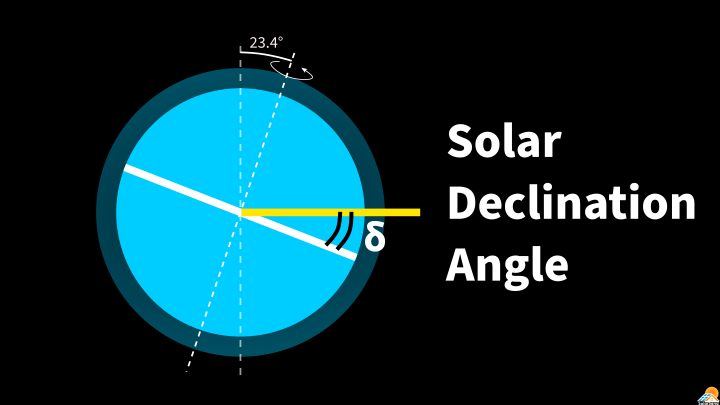The solar hour angle tells us about the location of the sun in the sky. Estimating the position of the sun is very important in photovoltaic and solar thermal design.
Solar hour angle calculator
Select the date, time, and your time zone and enter your longitude to calculate the solar angle hour.
What is the solar hour angle?
The solar hour angle is a measure of the angular distance between the sun at the local solar time and the sun at solar noon. It is expressed in degrees or radians.
The sun rises from the east and reaches its highest position at solar noon. Then, it descends to the west. By definition, the solar hour angle is zero degrees at solar noon.
There are 24 hours in a day, and in that period, the earth rotates 360°. So, the earth rotates 15° every single hour.
Thus, after each hour from solar noon, the hour angle increases by 15°. And before each hour from solar noon, the hour angle decreases by 15°. Presuming the solar noon at 12 o’clock, at 1:00 PM (13:00), the solar hour angle will be 15°, and at 2:00 PM (14:00), the solar hour angle will be 30°. In the same way, at 11:00 AM, the solar hour angle will be −15°, and at 10:00 AM, the solar hour angle will be −30°.
The image below depicts the same.

In the morning, the solar hour angle will always be negative, while in the afternoon, it will always be positive.
The cosine of the solar hour angle is used for calculating the zenith angle or the solar elevation angle. Since the cosine of a negative number is the same as the positive number, the solar elevation will remain unaffected by the negative and positive values of the solar hour angle. In other words, the solar elevation will be the same for −15° (11:00 AM) and +15° (1:00 PM).
The hour angle is also used in calculating the solar azimuth angle.
Solar hour angle formula
Let LST be the local solar time in the 24-hour format. The solar hour angle (h) in degrees is as follows:
In the above equation, the local solar time (LST) is in hours. We can convert LST in hours to LST in minutes.
Using the above formula, we can quickly calculate the solar hour angle for any time. For example, at 3:30 PM, h = 15° × (15.5 − 12)= 52.5°. However, this number is a rough estimate. The real solar hour angle will slightly differ from this calculation.
Corrections
There are two corrections that we need to incorporate into the previous equation.
The first is the equation of time, which corrects the eccentricity of the earth’s orbit and its axial tilt. The empirical equation to estimate the equation of time (EoT) in minutes is as follows:
Here, ɣ is the fraction year in radians and determined by the following equation:
The source for these equations is National Oceanic and Atmospheric Administration (NOAA).
We have to insert the number of days since January 1st (UTC 00:00:00) to determine ɣ. For example, November 24th (UTC 00:00:00) will be 327 days.
The second correction is incorporating the longitudinal variation (LongV). And it is determined by the below equation.
Here, longitude is in the degree and is negative to the west. ΔTZ is the difference in the local time zone to the universal time (UTC). For example, Los Angeles is in UTC−8. So, ΔTZ = −8. Boston is in UTC−5. So, ΔTZ = −5.
The total offset (in minutes) in the solar time will be the addition of the two corrections.
Finally, the corrected local solar time (LSTcorr) is LST + Offset. And using this corrected LST, we can calculate the solar hour angle with more accuracy.
How to calculate the solar hour angle?
Let’s take an example to better understand the above formulae.
Los Angeles is at longitude 118.24° West; Longitude = −118.24°. It falls in Pacific Standard Time (UTC−8); ΔTZ = −8.
We want to find the solar hour angle at 3:30 PM on November 24th.
The fractional year in radians is
From ɣ, we calculate the equation of time.
Thus, the offset is as follows:
From the offset, the corrected LST is LST + Offset = 15.5 + 20.36/60 = 15.84 hours.
The solar hour angle for a given data is h = 15 × (15.84 − 12) = 57.6°. The corrected angle differs by 57.6° − 52.5° = 5.1°.
FAQs
What is the hour angle at solar noon?
At solar noon, the hour angle is zero degrees.
What is the hour angle at 10 AM?
The hour angle at 10 AM is roughly equal to −30°.
What is the relation between the solar hour angle and solar energy?
For a particular region on the earth, we receive the maximum solar energy per unit area around solar noon. So, the solar power generation is maximum when the solar hour angle is close to zero.



